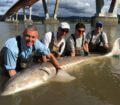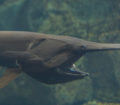John’s Note: When you think of freshwater fish, anything over 10 pounds usually is considered big – very big. But, there are five real giants, topping or approaching the 100-pound mark, that lurk in the depths of America’s freshwater lakes and rivers. Here’s what they are, where they live, and how you can do battle with them.
 Although there are several species of gar, including the needlenose, the longnose, the shortnose and the spotted, the alligator gar (lepisosteus spatula) is the biggest of the species, weighing up to 300-pounds plus with the corroborated record being 279 pounds taken in the Rio Grande River in Texas. The alligator gar from the Mesozoic Era, is found up the Mississippi River basin, along the Gulf of Mexico, in the Ohio River and also in Central America and China. These fish are able to thrive in stagnant, shallow water because their modified gas bladders help them breathe air.
Although there are several species of gar, including the needlenose, the longnose, the shortnose and the spotted, the alligator gar (lepisosteus spatula) is the biggest of the species, weighing up to 300-pounds plus with the corroborated record being 279 pounds taken in the Rio Grande River in Texas. The alligator gar from the Mesozoic Era, is found up the Mississippi River basin, along the Gulf of Mexico, in the Ohio River and also in Central America and China. These fish are able to thrive in stagnant, shallow water because their modified gas bladders help them breathe air.
The alligator gar was considered useful to early man. Indians once utilized the gar’s skin for armor and its scales for arrowheads. And, in recent years, the hides, which are very durable, have been used for making tools and luggage. Although the alligator gar resembles a log or a rock lying in the rivers when it is basking in the sun and seems slow-moving, this fish can act quickly if it wants. An alligator gar is even stronger than an alligator and can kill with a bite of its mighty jaws, which contain double rows of large, razor-sharp teeth.
 Anglers fish for gar with all types of tackle, including floating a bait in the center of a noose, so that the noose will hold the gar around its gills when it strikes, or floating a bait on a jug and/or trolling frayed nylon rope in the water to attract the gar whose teeth are held fast in the ropes when the gar attacks. But, the most-productive method of taking alligator gar with a maximum of sport is to employ 20-pound-test line. Anglers use plenty of line, a good drag, a stout rod, a No. 5 treble hook, 18-20 inches of 50- to 150-pound-test, single-strand wire leader and lead. In the Gulf Coast area, sportsmen who use this tackle to take fierce-fighting gar, prefer a stiff worm rod and a clicker type of reel. They add enough lead to the line to keep the bait on the bottom. Next, below the slip lead, they attach 18 inches of 50- to 150-pound test, single-strand wire leader. Then, they connect a large treble hook to the leader. Although each angler has his own special bait, the most popular bait for gar is usually mullet, because one mullet can be cut up to make enough bait to fish for three gar.
Anglers fish for gar with all types of tackle, including floating a bait in the center of a noose, so that the noose will hold the gar around its gills when it strikes, or floating a bait on a jug and/or trolling frayed nylon rope in the water to attract the gar whose teeth are held fast in the ropes when the gar attacks. But, the most-productive method of taking alligator gar with a maximum of sport is to employ 20-pound-test line. Anglers use plenty of line, a good drag, a stout rod, a No. 5 treble hook, 18-20 inches of 50- to 150-pound-test, single-strand wire leader and lead. In the Gulf Coast area, sportsmen who use this tackle to take fierce-fighting gar, prefer a stiff worm rod and a clicker type of reel. They add enough lead to the line to keep the bait on the bottom. Next, below the slip lead, they attach 18 inches of 50- to 150-pound test, single-strand wire leader. Then, they connect a large treble hook to the leader. Although each angler has his own special bait, the most popular bait for gar is usually mullet, because one mullet can be cut up to make enough bait to fish for three gar.
The angler out for alligator gar must know how the gar eats to take the fish successfully. The gar approaches its food sideways and slyly before it suddenly takes the food and holds it in its mouth. Then, by a series of movements, the gar places the bait in the proper position to be swallowed. So, patience is required to wait on the gar to swallow the bait, because driving a hook into the gar’s hard, bony mouth is difficult. If you research guides for alligator gar, you’ll find about 10 listed on the internet. Today many anglers also enjoy bowfishing for gar.
 To learn more about fishing, you can get John E. Phillips’ eBooks and print books at www.amazon.com/author/johnephillips or at www.barnesandnoble.com.
To learn more about fishing, you can get John E. Phillips’ eBooks and print books at www.amazon.com/author/johnephillips or at www.barnesandnoble.com.










